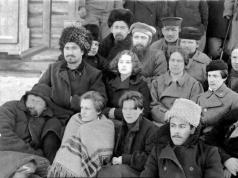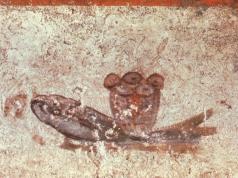Presentation on the topic "Building animal cell" can be downloaded absolutely free on our website. Project subject: Biology. Colorful slides and illustrations will help you interest your classmates or audience. To view the content, use the player, or if you want to download the report, click on the corresponding text under the player. The presentation contains 1 slide (s).
Presentation slides
Slide 1
The cell membrane is located underneath the cell wall. Functions: limits the contents of the cell; protects the cell; regulates metabolism with the external environment.
Cytoplasm is a viscous fluid that fills the cell; neighboring cells are connected to each other through the cytoplasm. Functions: accumulation of cell waste products; storage of nutrients.
The nucleus contains chromosomes; covered with a shell. Functions: participates in the storage and transmission of hereditary information to offspring; regulates all processes in the cell.
The nucleolus is an accumulation of nuclear substance in the nucleus. Functions: participates in the formation of ribosomes.
Ribosomes are round in shape and small in size; located freely in the cytoplasm or attached to the endoplasmic reticulum. Functions: formation (synthesis) of proteins.
Endoplasmic reticulum(ER) consists of tubules forming a network; It has own shell. Functions: formation of organic substances (proteins, fats and carbohydrates); transport of substances in the cell.
The Golgi apparatus consists of tubules, cavities and vesicles; covered with its own shell. Functions: formation of complex organic substances; formation of lysosomes.
Lysosomes are small vesicles; contains enzymes; have their own shell. Functions: breakdown of organic substances (proteins, fats, carbohydrates).
Mitochondria are oval in shape; covered with a double shell; the inner shell forms folds. Functions: formation and accumulation of energy (“energy stations” of the cell).
Cell center consists of two parts having a cylindrical shape Functions: participation in cell division
Click to select a part of the cell
The structure of an animal cell
Tips for making a good presentation or project report
- Try to involve the audience in the story, set up interaction with the audience using leading questions, a game part, do not be afraid to joke and smile sincerely (where appropriate).
- Try to explain the slide in your own words, add additional Interesting Facts, you don’t need to just read the information from the slides, the audience can read it themselves.
- There is no need to overload the slides of your project with text blocks; more illustrations and a minimum of text will better convey information and attract attention. The slide should contain only key information; the rest is best told to the audience orally.
- The text must be well readable, otherwise the audience will not be able to see the information being presented, will be greatly distracted from the story, trying to at least make out something, or will completely lose all interest. To do this, you need to choose the right font, taking into account where and how the presentation will be broadcast, and also choose the right combination of background and text.
- It is important to rehearse your report, think about how you will greet the audience, what you will say first, and how you will end the presentation. All comes with experience.
- Choose the right outfit, because... The speaker's clothing also plays a big role in the perception of his speech.
- Try to speak confidently, smoothly and coherently.
- Try to enjoy the performance, then you will be more at ease and less nervous.
The structure of an animal cell.
The presentation was made by Borisova G.A.
Teacher MBOU Pervomaiskaya secondary school


- The origin of the concept of a cell
- 1590 The Jansen brothers (invention of the microscope), 1665. R. Hooke (introduced the term “cell”), 1680 A. Levenguk (discovered single-celled organisms), 1831. R. Brown (discovery of the nucleus).
- 1590 Jansen brothers (invention of the microscope),
- 1665 R. Hooke (introduced the term “cell”),
- 1680 A. Levenguk (discovered single-celled organisms),
- 1831 R. Brown (discovery of the nucleus).

Emergence cell theory.
1838 T. Schleiden (plant tissues consist of cells),
1839 M. Schwann (animal tissues consist of cells). Formulated the basic position of cell theory: Cells constitute the structural and functional basis of all living things).

Development of cell theory.
1858 R. Virchow. (each new cell comes only from a cell as a result of its division),
1930 – creation of an electron microscope.

Types of cells:
Animal
Vegetable
Bacterial





- Nucleus Cytoplasm Surface apparatus Organelles
- Cytoplasm
- Surface apparatus
- Organoids







1. Who first discovered the cell?
a) Robert Virchow;
b) Antoine Van Leeuwenhoek;
c) Robert Hooke.
2. What year?

3. The outside of the cage is covered with:
a) cytoplasm;
b) shell;
c) plastids.
4. Green plastids are called:
a) leukoplasts;
b) chloroplasts;
c) chromoplasts

4. Internal environment the cells where all the organelles are located are called:
a) cytoplasm;
c) vacuoles.
5. Chromosomes are located in:
b) cytoplasm;
c) vacuoles.

6. Main structural unit body:
a) root;
c) cell.

animal cell
Cytoplasmic membrane
Golgi apparatus
Lysosome
Centrioles
Cytoplasm
Endoplasmic
Mitochondria

Organoids
Structure
Plasma membrane
Functions
Endoplasmic reticulum (ER)
Ribosomes
Mitochondria
Golgi apparatus
Lysosomes
Cell center


Internet resources.
http:// fizrast.ru/fiziol-kletka/stroenie.html
http://dic.academic.ru/dic.nsf/enc_biology/1816/ PLANT
https://ru.wikipedia.org/wiki / Plant cells
http:// http:// biouroki.ru/material/plants/kletka.html
http:// fb.ru/article/43885/stroenie-rastitelnoy-kletki
http:// biouroki.ru/material/plants/kletka.html
http:// otvet.mail.ru/question/77344331

“The structure of the cell and its functions” - Cell theory. DNA molecule. Chromatin. Potassium is a sodium pump. 3. Nucleolus (protein and r-RNA). Flagella (single cytoplasmic projections on the membrane). Endoplasmic reticulum. Comparison of cells of different kingdoms. The presentation was made by Protsenko L.V. teacher at Municipal Educational Institution “Gymnasium No. 10”. ... Plant cell. Structure.
“Organic substances of the cell” - What organic substances are included in the composition of cells? Consolidate the acquired knowledge. Plant and animal proteins. Plan. Lipids. Organic compounds cells: proteins, fats, carbohydrates. List the functions of proteins. Klyuchantseva Irina Nikolaevna biology teacher at the Municipal Educational Institution “Itatskaya Secondary School No. 2” in the village of Tomskoye. Draw a conclusion.
“Cell structure” - Vacuole. Put the skin on. Vacuoles. Computer science category I. Green plastids You will search in vain. Cell structure. Municipal educational institution "Klyukvenskaya secondary" comprehensive school". The preparation is on the table, Core. Preparation and examination of the preparation of onion scale skin under a microscope. Biology 6th grade.
"Cell nucleus" - 80 S ribosomes. The functions of the nucleus in a prokaryotic cell are performed by the Golgi apparatus. From. DNA Organoids. Simple and complex. Conjugation. Membrane organelles. The endoplasmic reticulum is folded. Hypothesis. Problematic question. Comparative characteristics eukaryotic and prokaryotic cells. The endoplasmic reticulum is smooth.
“The chemical composition of the cell” - Well done!!! Goal: get to know chemicals cells. Inorganic substances. 1-Transmission and storage of hereditary information. 2-part of chromosomes. Next question. Squirrels. From 1 kg of fat 1.1 kg of water is formed. Carbohydrates. Potato tubers contain up to 80% carbohydrates, and liver and muscle cells contain up to 5% carbohydrates.
"Cell and Nucleus" - Oligosaccharide side chain. Transport proteins. Karyolemma. Nucleoli. Cell structure. Cholesterol. Inclusions. Membrane proteins. Non-permanent components. Plastids Mitochondria Lysosomes, etc. The model of G. Nicholson and S. Singer resembles a mosaic. Karyoplasm. Kernel components. Channel-forming proteins. Round bodies formed by rRNA molecules and proteins, the site of ribosome assembly.
There are a total of 16 presentations in the topic
To use presentation previews, create an account for yourself ( account) Google and log in: https://accounts.google.com
Slide captions:
Completed by a biology teacher at MBOU "Secondary School" pst. Chinyavoryk S.S. Kuzmina
General information 1 The bodies of all living organisms are made up of cells. Most animal bodies are made up of many cells.
General information 2 There are organisms whose bodies consist of only one cell - these are bacteria, unicellular algae, fungi, and protozoa.
General information 3 The science of CYTOLOGY studies the structure, development and activity of cells.
General information 4 Most animal cells are very small. The shapes of animal cells are very different. Muscle cells Blood cells Skin cells The shape and size of animal cells depend on the function of the cell
cytoplasm mitochondria chromosomes ribosomes Endoplasmic reticulum Golgi apparatus nucleolus Cell membrane lysosome centriole core Digestive vacuole Scheme of the structure of an animal cell
ORGANOIDS STRUCTURE FUNCTIONS Endoplasmic reticulum Ribosomes Mitochondria Golgi apparatus Lysosomes §6, page 26
Plant cell Animal cell Difference Similarity §6, page 26 Homework
Tissue is a group of cells similar in structure and function and the intercellular substance secreted by these cells.
Epithelial (cover) tissue Connective tissue Muscle Nervous tissue Tissues
Epithelial tissue Forms the integument of animals, lining body cavities and internal organs; Consist of one or several layers of tightly adjacent cells and contain almost no intercellular substance;
Connective tissue Consists of a small number of cells scattered in a mass of intercellular substance; It is part of the skeleton, supports the body, creates support, and protects internal organs.
Muscle tissue Consists of elongated cells that receive irritation from the nervous system and respond to it with irritation; Through contraction and relaxation skeletal muscles animal movement occurs.
Nervous tissue forms nervous system, which consists of nerve cells– neurons; Neurons have a stellate shape, long and short processes. Neurons perceive irritation and transmit excitation to muscles, skin, and other tissues and organs.
Tissue Function Types of tissue Epithelial Connective Muscular Nervous ----------
Homework §6-7, on pages 26-29, preparing for test work on the topics “Cell” and “Tissues”
summary of other presentations
“Structure of a human cell” - The cell is covered with a membrane. Chemical composition cells. The human body. Cell. Questions after the paragraph. Vital properties of the cell. Cytoplasm. Cytology. Inorganic substances. Thread-like formations. Organic matter. Internal environment of the body.
“Structure of plant cell organelles” - Golgi complex. Basic processes. Organoids. Nucleus with chromosomes. Structure plant cell. Diagram of the structure of a plant cell. Cell membrane. Mitochondria. Endoplasmic reticulum. Vacuole. Cytoplasm. Discovery of cells. Chloroplasts. The structure of the cell of a prokaryotic organism. Plant cell.
“Organoids of a eukaryotic cell” - Plant and animal cells. Developmental goals. What organelles are shown in these figures. Mitochondria is the powerhouse of the cell. Compare the cells. Organelles of a eukaryotic cell. Lesson objectives. Cell organelles. Cage travel worksheet. Cellular center. Golgi apparatus. Animal cell. Organelles of an animal cell. Diversity of cells. Types of plastids. Plastids. Organoids for special purposes.
“Structure of animal and plant cells” - Functions of the EPS. Vessels. The structure of a plant and animal cell. Functions of lysosomes. Golgi apparatus. Membrane functions. High-energy-intensive (macroenergetic) bonds. Protein. Cell structure. Glucose. Functions of plastids. Function of the cell center. Transcription. Cell. Micrograph of the endoplasmic reticulum. Cell wall. Presentation navigation. Ribosome. Lysosome. Cellular center. Outer membrane. Phospholipid.
“Structural features of eukaryotic cells” - Cell. Plasma (cell) membrane. R. Virchow. Leeuwenhoek. Cellular center. Inclusions. Cytoplasm. Lysosomes. Diversity and structural features of cells. Ribosomes. Dictionary. Endoplasmic reticulum. Cells that do not have a formed nucleus. Cilia and flagella. The structure of a eukaryotic cell. Diversity of cells. Golgi apparatus (complex). Core. Mitochondria. Variety of viruses. Cell structure.
“Structure of a eukaryotic cell” - Eukaryotic cell. Core. Organelles common to plant and animal cells. Inclusions. Squirrels cell membranes. Organelles characteristic of a plant cell. Functions of membrane proteins. Properties of cell membranes. It's time. Structure. Functions. Organoids. Cellular forms life. Cell shapes. Universal unit of life. Hook. Structure plasma membrane. Endoplasmic reticulum. Main functions of the membrane.








